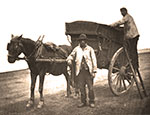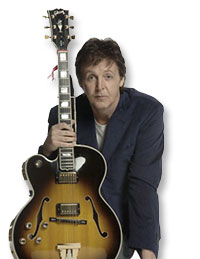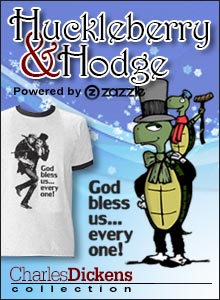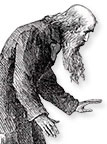Charles Dickens'
Our Mutual Friend
Our Mutual Friend - The Corruptive Power of Wealth
Our Mutual Friend - Published in monthly parts May 1864 - Nov 1865
Charles Dickens' fourteenth novel was his last completed work. Having ended his long association with Hablot Browne, Our Mutual Friend was illustrated by Marcus Stone and was the first monthly serialized Dickens novel to use woodcuts instead of steel plates for the illustrations (Patten, 1978, p. 303). The story centers on the effects of greed and the corruption that money brings. The writing was slow and the monthly installments were not selling well (Patten, 1978, p. 308-309).
Dickens was beginning to feel the effects of illness that would plague him the rest of his life.
Despite a scathing contemporary review in The Nation by Henry James ("the poorest of Mr Dickens's works") Sean Grass, in his book Charles Dickens's Our Mutual Friend: A Publishing History (2016), reports:
...the collected reviews tell us something that comes as a serious surprise: for all that James's place in the history of the novel—and, for that matter, in the history of criticism on the novel—has given his review of Our Mutual Friend a persistent significance for scholars, he was nearly alone in writing so negatively of the novel in 1865, and he was one of only two reviewers to do so in the absence of some longstanding antipathy to Dickens on the part of the magazine for which he wrote. Of the 41 reviews, only 4 are thoroughly negative, and these include James's and those published by Dickens's old enemies at the 'Saturday' and 'Westminster.'
Modern critics generally consider it one of the great social novels of Dickens' later period.
Plot
(contains spoilers)
John Harmon, son of a wealthy dust contractor and heir to his father's fortune if he agrees to marry Bella Wilfer, is away from England when his father dies. On the way home he is supposed drowned in a case of mistaken identity. With his supposed death the dust fortune goes to Boffin, his father's former servant. John intrigues himself into the Boffin home as secretary John Rokesmith. Here he meets Bella and, with the help of the kindly Boffins, wins her love as Rokesmith and marries her. He later reveals his true identity and regains his fortune.
Complete List of Characters:
Character descriptions contain spoilersOur Mutual Friend Links:
Our Mutual Friend-The Scholarly Pages
Wikipedia
From Fagin to Riah: How Charles Dickens looked at the Jews - Herb Moskovitz
Read Clayton Burns' short novel Bradley Headstone
Mr Riah
The stereotypical depiction of Fagin in Oliver Twist raised concern with the Jewish community. When Charles Dickens sold his London residence, Tavistock House, to a Jewish couple, whom he befriended, he was compelled to make restitution. In Our Mutual Friend Dickens created Riah, a positive Jewish character. Dickens also, when editing Oliver Twist for the Charles Dickens edition of his works, eliminated most references to Fagin as "the Jew" (Slater, 2009, p. 516-517).Staplehurst Railway Accident
On Friday the 9th of June 1865 Charles Dickens and his traveling companions, Ellen Ternan and her mother, were returning from a trip to France. They boarded the 'tidal train', which waited for steamers arriving on the tide, at Folkestone for the trip to London.
Just outside of the village of Staplehurst, about halfway between Folkestone and London, workmen were repairing a section of the rails on a bridge over the  River Beult and had removed a 40 foot section of rail. The foreman of the work detail had consulted the wrong timetable and was completely unaware of the train bearing down on them at 50 miles an hour.
River Beult and had removed a 40 foot section of rail. The foreman of the work detail had consulted the wrong timetable and was completely unaware of the train bearing down on them at 50 miles an hour.
Unable to stop in time, the train jumped the gap in the rail and slammed into the bank on the far side of the river. The carriage carrying Dickens and his companions was suspended from the bridge and hanging down to the riverbed. Helping Miss Ternan and her mother out of the car Dickens then worked to comfort the injured and dying passengers, using his hat to carry water from the river (Letters, 1999, v. 11, p. 56-57).
Later he remembered that he had left that month's manuscript of his current novel, Our Mutual Friend, in the tottering railway carriage. He climbed back into the car and retrieved the manuscript.
In the aftermath of the accident Dickens felt weak and shaken, unable to write, and his pulse was feeble. Three years after the crash he would write that he still experienced "vague rushes of terror" even riding in hansom cabs (Letters, 1903, p. 697). Dickens continued to suffer the ill effects of the ordeal until his death on June 9, 1870, exactly five years after the accident (Johnson, 1952, p. 1020-1021).
Dickens commented on the accident in a postscript in the last monthly installment of Our Mutual Friend dated September 2, 1865:
On Friday the ninth of June in the present year Mr and Mrs Boffin (in their manuscript dress of receiving Mr and Mrs Lammle at breakfast) were on the South Eastern Railway with me, in a terribly destructive accident. When I had done what I could to help others, I climbed back into my carriage -- nearly turned over a viaduct, and caught aslant upon the turn -- to extricate the worthy couple. They were much soiled, but otherwise unhurt. The same happy result attended Miss Bella Wilfer on her wedding-day, and Mr Riderhood inspecting Bradley Headstone's red neckerchief as he lay asleep. I remember with devout thanksfulness that I can never be much nearer parting company with my readers for ever, than I was then, until there shall be written against my life the two words with which I have this day closed this book -- THE END (Our Mutual Friend, p. 822)
- Sketches by Boz |
- Pickwick |
- Oliver Twist |
- Nickleby |
- Old Curiosity Shop |
- Barnaby Rudge |
- Chuzzlewit |
- Christmas Carol |
- Christmas Books |
- American Notes |
- Pictures from Italy |
- Dombey and Son |
- Copperfield |
- Bleak House |
- Hard Times |
- Little Dorrit |
- Tale of Two Cities |
- Great Expectations |
- Our Mutual Friend |
- Edwin Drood |
- Minor Works |
- The Uncommercial Traveller |
- Short Stories

 Novelist John Irving credits Charles Dickens as a major influence on his writing. Irving says he has read all of Dickens' novels except one, he has not read Our Mutual Friend. Irving says he saving it for old-age or a severe illness. That way he knows he will have at least one good book to read
Novelist John Irving credits Charles Dickens as a major influence on his writing. Irving says he has read all of Dickens' novels except one, he has not read Our Mutual Friend. Irving says he saving it for old-age or a severe illness. That way he knows he will have at least one good book to read 






